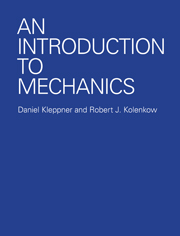Book contents
- Frontmatter
- Contents
- LIST OF EXAMPLES
- PREFACE
- TO THE TEACHER
- AN INTRODUCTION TO MECHANICS
- 1 VECTORS AND VECTORS KINEMATICS—A FEW MATHEMATICAL PRELIMINARIES
- 2 NEWTON'S LAWS—THE FOUNDATIONS OF NEWTONIAN MECHANICS
- 3 MOMENTUM
- 4 WORK AND ENERGY
- 5 SOME MATHEMATICAL ASPECTS OF FORCE AND ENERGY
- 6 ANGULAR MOMENTUM AND FIXED AXIS ROTATION
- 7 RIGID BODY MOTION AND THE CONSERVATION OF ANGULAR MOMENTUM
- 8 NONINERTIAL SYSTEMS AND FICTITIOUS FORCES
- 9 CENTRAL FORCE MOTION
- 10 THE HARMONIC OSCILLATOR
- 11 THE SPECIAL THEORY OF RELATIVITY
- 12 RELATIVISTIC KINEMATICS
- 13 RELATIVISTIC MOMENTUM AND ENERGY
- 14 FOUR VECTORS AND RELATIVISTIC INVARIANCE
- INDEX
2 - NEWTON'S LAWS—THE FOUNDATIONS OF NEWTONIAN MECHANICS
- Frontmatter
- Contents
- LIST OF EXAMPLES
- PREFACE
- TO THE TEACHER
- AN INTRODUCTION TO MECHANICS
- 1 VECTORS AND VECTORS KINEMATICS—A FEW MATHEMATICAL PRELIMINARIES
- 2 NEWTON'S LAWS—THE FOUNDATIONS OF NEWTONIAN MECHANICS
- 3 MOMENTUM
- 4 WORK AND ENERGY
- 5 SOME MATHEMATICAL ASPECTS OF FORCE AND ENERGY
- 6 ANGULAR MOMENTUM AND FIXED AXIS ROTATION
- 7 RIGID BODY MOTION AND THE CONSERVATION OF ANGULAR MOMENTUM
- 8 NONINERTIAL SYSTEMS AND FICTITIOUS FORCES
- 9 CENTRAL FORCE MOTION
- 10 THE HARMONIC OSCILLATOR
- 11 THE SPECIAL THEORY OF RELATIVITY
- 12 RELATIVISTIC KINEMATICS
- 13 RELATIVISTIC MOMENTUM AND ENERGY
- 14 FOUR VECTORS AND RELATIVISTIC INVARIANCE
- INDEX
Summary
Introduction
Our aim in this chapter is to understand Newton's laws of motion. From one point of view this is a modest task: Newton's laws are simple to state and involve little mathematical complexity. Their simplicity is deceptive, however. As we shall see, they combine definitions, observations from nature, partly intuitive concepts, and some unexamined assumptions on the properties of space and time. Newton's statement of the laws of motion left many of these points unclear. It was not until two hundred years after Newton that the foundations of classical mechanics were carefully examined, principally by Ernst Mach, and our treatment is very much in the spirit of Mach.
Newton's laws of motion are by no means self-evident. In Aristotle's system of mechanics, a force was thought to be needed to maintain a body in uniform motion. Aristotelian mechanics was accepted for thousands of years because, superficially, it seemed intuitively correct. Careful reasoning from observation and a real effort of thought was needed to break out of the aristotelian mold. Most of us are still not accustomed to thinking in newtonian terms, and it takes both effort and practice to learn to analyze situations from the newtonian point of view. We shall spend a good deal of time in this chapter looking at applications of Newton's laws, for only in this way can we really come to understand them.
- Type
- Chapter
- Information
- An Introduction to Mechanics , pp. 51 - 110Publisher: Cambridge University PressPrint publication year: 2010

